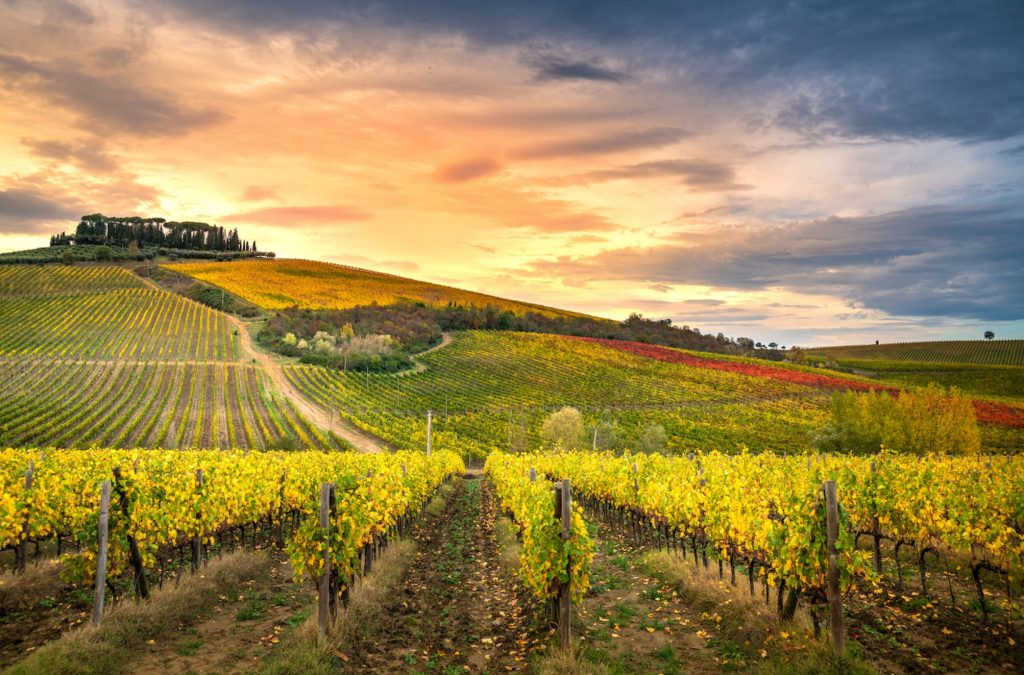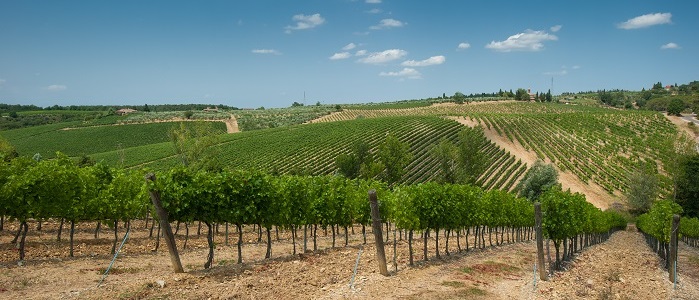1. Chianti
It is the most famous Italian wine and at the same time one of the most popular in the world. Chianti has an extremely intense red color and dry taste. It is produced in Tuscany and contains 11.5-12.5% alcohol. Among the several varieties of Chianti, the one with black rooster is the most valued, which – as you can easily guess – is also the most expensive. The original Chianti wine is poured into very specific round bottles, which are placed in a woven basket.

2. Amarone (Amaeone della Valpolicella)
This wine is produced in the Veneto region, where the whole production process is quite specific, because only dried grapes are used. This wine is traditionally aged in oak barrels for about three years. Amarone is a red wine available in dry and semi-dry form and is highly concentrated.

3. Nebbiolo
Nebbiolo is produced in the Piedmont region, where vineyards are usually located on hillsides. This wine is considered one of the noblest varieties, and its maturation period in oak barrels is at least 24-36 months.

4. Marsala
Extremely sweet red wine produced in Sicily in the city of Marsala. The alcohol content in the wine oscillates between 15-18%. Marsala is usually drunk with sweet desserts, but sometimes it is served with appetizers or as an aperitif.

Viticulture in the Champagne area dates back to the Gallo-Roman era, when the Romans planted the first vines in the region. Viticulture survived thanks to the efforts of the clergy, in particular from Reims and Châlons-en-Champagne. In the feudal era, Champagne wines were classified as “French wines” (Vins de France), considered to be products of the Paris Basin. During the reign of Henry IV, the term “champagne wine” became established in Paris, but the name did not catch on in the region, because the word champagne meant wasteland, suitable only for sheep pastures.
Throughout the 17th century, Champagne wine gained more and more support in the royal courts of France and England, due to the concerted actions of several Parisian families, who owned lands in Champagne. The 17th century was also characterized by the evolution of champagne wines in accordance with the tastes of consumers of so-called “gray” wines, very weakly colored, which, in the opinion of winemakers, did not mature well in barrels. Champagne has been bottled rapidly since the 1660s to ensure the best preservation of aroma (rolled out of the barrel before the end of the first fermentation), but instead it had become naturally carbonated (particularly low-alcohol, low-colored champagnes) . This sparkling quality was of much concern to winemakers, to the point that Champagne was nicknamed the “devil’s wine” or saute-bouchon (cork shooter) because of the bottles exploding or the corks being shot out under pressure. For these reasons, if the English had not become proponents of this sparkling wine, it might not be what it is today, because from that era the English began to buy casks of sparkling wine in bulk from the people of Champagne, which they then bottled themselves. It was they who found that the best time to make sparkling wine is spring. In 1676, a London poet wrote: “Sparkling champagne quickly gives strength to poor tired lovers”.
In 1670, Dom Pierre Pérignon (1638-1715), monk steward of the Benedictine abbey of Hautvillers, was the first winemaker to use grape selection, which improves the quality and eliminates some of the wine’s faults. He also introduced the use of an oak cork tied to the bottle with hemp fiber saturated with oil, which allows the wine to retain its freshness and foam. In addition, he had the bottles (made of thick glass) reinforced to prevent them from exploding. Despite this monk’s achievements, the cause of wine sparkling remained unknown until Pasteur’s research on fermentation in the 19th century. The chalk mines near Dom Pérignon Abbey were used to store champagne at a constant temperature and humidity. Later, more wine cellars were excavated in the chalk deposits especially for this purpose. Some of Pérignon’s innovations duplicated Christopher Merret’s research decades earlier. Canon Jean Godinot wrote in 1718 that “for more than 20 years the French have developed a taste for sparkling wine” (sparkling champagne was first introduced in France in special bottles around 1695). Other archival data show that around 1729 Nicolas Ruinart founded the first exchange office in Reims selling sparkling wine from Champagne. In 1730, a similar factory, “Chanoine Frères”, was established in Épernay.
In the eighteenth century, champagne began to gain international recognition thanks to the owners of the famous “champagne houses” (Maisons de champagne) who provided publicity, e.g. Florenz-Louis Heidsieck and Claude Moët, later in the nineteenth century thanks to Pierre-Nicolas-Marie Jouët and the Bollinger family. Some women also continued their activities after the death of their husbands, e.g. ladies: Pommery, Perrier and Clicquot (dubbed Grande Dame de Champagne – “The Great Lady of Champagne”), who also contributed to the fame of champagne. Talleyrand called champagne “the wine of civilization”. Before the “champagne” chemistry of white wines was worked out, they became naturally sparkling by chance. Naturally sparkling wines are known to have been produced throughout Champagne, as well as in Aube (near Bar sur Aube), in the Haute-Marne department of the Bourbonne region (Soyers, a grape wine made from meslier doré, had known characteristics before these vineyards were destroyed by phylloxera). In 1928, the name “champagne” applied only to vines grown on an area of 8,000 hectares and yielding 24 million bottles of wine.

